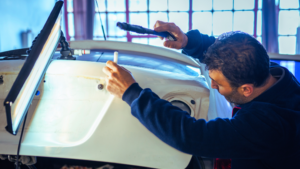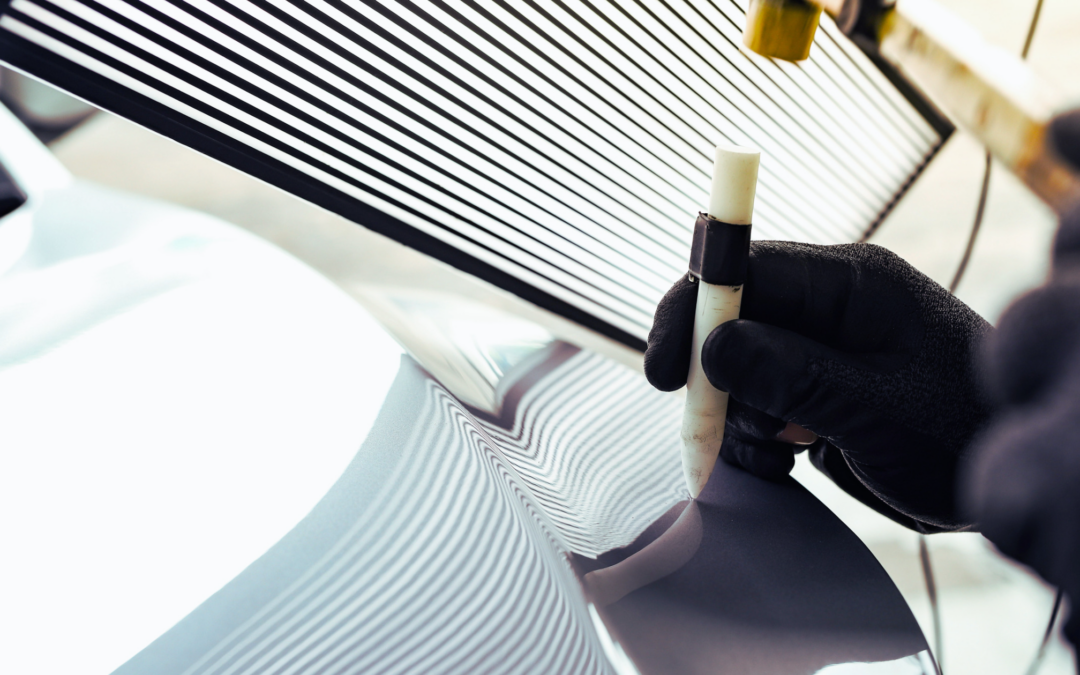Introduction
When it comes to dealing with dents and dings on your vehicle, you have options. Two popular methods for dent removal are paintless dent removal (also known as paintless dent repair) and traditional dent removal. Understanding the differences between these approaches can help you make an informed decision and restore your vehicle’s appearance efficiently. In this article, we will explore the benefits and limitations of both paintless dent repair and traditional dent removal, allowing you to choose the right method for your needs and ensure you receive quality service in the Saint Louis area.
What is Paintless Dent Repair?
Paintless dent repair(PDR) is a technique used to repair dents on a vehicle without requiring paintwork. It is a non-intrusive method that preserves the original factory finish of the vehicle, making it an attractive option for many car owners. PDR is especially effective for dents caused by hail damage, door dings from other cars or shopping carts, parking lot mishaps, or small accidents.
How Does Paintless Dent Repair Work?
The process of paintless dent repair involves using specialized tools. These tools gently massage the dented area from the inside of body panels, carefully manipulating the metal back into its original shape. Skilled technicians can access the back of the dent through existing openings, such as door panels or the trunk, or by removing inner panels when necessary.

Advantages of Paintless Dent Repair
Paintless dent repair offers several advantages over traditional dent removal methods:
- Preserves the original paint: With PDR, there is no need to repaint the repaired area, as the process does not damage the paintwork. This ensures that the vehicle maintains its original factory finish and helps retain its resale value.
- Faster repairs: PDR is generally quicker compared to traditional dent removal methods. Skilled technicians can often complete the repair within a few hours, depending on the dent’s severity. This saves you time and minimizes the inconvenience of being without your vehicle.
- Cost-effective: Since there is no need for repainting or extensive labor, paintless dent repair is typically more affordable than traditional dent repair methods. The savings in labor and materials make it an attractive option for those looking to minimize expenses while restoring their vehicle’s appearance.

What is Traditional Dent Removal?
Traditional dent removal, also known as conventional dent repair, involves the use of body filler and repainting to fix dents and dings on a vehicle. This method is effective for a wide range of dent types and can address more severe damage compared to paintless dent repair.
How Does Traditional Dent Removal Work?
In traditional dent removal, technicians use body filler to fill the dented area, shaping it to match the vehicle’s contours. Once the body filler has hardened, the surface is sanded, primed, and painted to achieve a seamless finish. This process requires skill and precision to ensure the repaired area blends seamlessly with the rest of the vehicle.
Advantages of Traditional Dent Removal
Traditional dent removal offers the following advantages:
- Suitable for severe dents: Traditional dent removal can effectively address larger or more complex dents, including those with paint damage or deep creases. The use of body filler and paint allows technicians to reshape and restore the damaged area, ensuring a smooth finish.
- Versatility: Unlike paintless dent repiar, which may be limited to certain dent types and sizes, traditional dent removal can be used for various dent scenarios. Whether it’s a result of a collision, parking lot mishap, or other accidents, traditional dent removal can often provide a reliable solution.
- Long-lasting repairs: The comprehensive process involved in traditional dent removal, including painting, ensures a durable and long-lasting repair. When done correctly, the repaired area seamlessly blends with the rest of the vehicle, making the dent virtually undetectable.
Factors to Consider When Choosing the Right Method
Several factors come into play when deciding whether paintless dent repair or traditional dent removal is the most suitable option for your vehicle.
Dent Severity
Paintless dent repair is most effective for less severe dents and dings, such as those caused by hailstones or small accidents, where the paint remains intact. On the other hand, traditional dent removal can address both minor and more severe dents, including those with paint damage or deep creases.
Paint Damage
If the dent has resulted in paint damage or the paint has chipped off, traditional dent removal by a body shop may be necessary to ensure a seamless repair. Paintless dent repair cannot fix paint damage and is limited to dents where the paint remains intact.
Time and Cost
Paintless dent repair generally requires less time compared to traditional dent removal. With PDR, dents can often be repaired within a few hours. Traditional dent removal may take longer due to the need for painting. Additionally, paintless dent repair is often more cost-effective since it eliminates the need for repainting and extensive labor.

Why Choose Paintless Dent Repair For Hail Damage
Hail damage can be a serious problem for car owners, as it can make their car or truck look unsightly and often reduce the vehicle’s value. For this reason, paintless dent repair is an excellent service that can restore a vehicle to its original condition after hail damage. Paintless dent repair is actually one of the most popular methods used for repairing hail damage to cars and other vehicles. It is ideal for customers who need their vehicles repaired quickly after hail damages their car.
Paintless dent repair is highly effective at restoring the original shape of metal surfaces. It is great for fixing the hail damage without ruining any factory-installed or ceramic finishes. Hail damage repair using PDR techniques allows the technician to accesses the dent from behind the damaged panel and gently push it back. This method is quick and efficient. There is no need for sanding, priming, or painting before or after fixing a dent caused by hail damage.
Hail damage repair using this technique could take only an hour or less. Of course this depends on how many hail damage dents need to be fixed. Some technicians even offer same-day services. Professional technicians can guarantee excellent results when repairing hail damage with paintless dent repair. This helps car owners save time and money compared to traditional body shop repairs or repainting processes.
Conclusion
Choosing between paintless dent repair and traditional dent removal depends on several factors, including dent severity, paint damage, time constraints, and cost considerations. Paintless dent repair is a non-intrusive, cost-effective, and efficient method for minor dents, hail damage, and door dings. This is in comparison to traditional dent removal which can handle more severe damage and paint-related issues. By understanding the benefits and limitations of each method, you can make an informed decision and find the right body shop to restore your vehicle to its former glory.
Frequently Asked Questions
Q: Can paintless dent repair be used for all types of dents?
A: Paintless dent repair is most effective for dents where the paint remains intact. If the dent has resulted in paint damage or the paint has chipped off, traditional dent removal may be necessary.
Q: Does paintless dent repair affect the vehicle’s paint warranty?
A: No, paintless dent repair does not affect the vehicle’s paint warranty. Since the original paint remains intact, there is no need for repainting, ensuring the warranty remains unaffected.
Q: Are paintless dent removal services good for cars with ceramic coatings?
A: Yes. PDR is a fantastic option for removing dents in cars or trucks with ceramic coatings.
Q: How long does paintless dent repair take?
A: The duration of paintless dent repair depends on the severity and complexity of the dent or quantity of hail damage. With PDR, dents can often be repaired within a few hours, while more extensive damage may require additional time.
Q: Should I attempt dent removal at home?
A: It is generally not recommended to attempt dent removal at home, especially if you lack the necessary experience and tools to get under your body panels easily. DIY dent repair attempts can potentially cause further damage to the vehicle. It is best to consult a professional dent repair technician for quality service.


